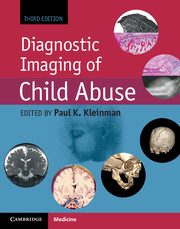Book contents
- Frontmatter
- Dedication
- Contents
- List of Contributors
- Editor’s note on the Foreword to the third edition
- Foreword to the third edition
- Foreword to the second edition
- Foreword to the first edition
- Preface
- Acknowledgments
- List of acronyms
- Introduction
- Section I Skeletal trauma
- Chapter 1 The skeleton: structure, growth and development, and basis of skeletal injury
- Chapter 2 Skeletal trauma: general considerations
- Chapter 3 Lower extremity trauma
- Chapter 4 Upper extremity trauma
- Chapter 5 Bony thoracic trauma
- Chapter 6 Dating fractures
- Chapter 7 Differential diagnosis I: diseases, dysplasias, and syndromes
- Chapter 8 Differential diagnosis II: disorders of calcium and phosphorus metabolism
- Chapter 9 Differential diagnosis III: osteogenesis imperfecta
- Chapter 10 Differential diagnosis IV: accidental trauma
- Chapter 11 Differential diagnosis V: obstetric trauma
- Chapter 12 Differential diagnosis VI: normal variants
- Chapter 13 Evidence-based radiology and child abuse
- Chapter 14 Skeletal imaging strategies
- Chapter 15 Postmortem skeletal imaging
- Section II Abusive head and spinal trauma
- Section III Visceral trauma and miscellaneous abuse and neglect
- Section IV Diagnostic imaging of abuse in societal context
- Section V Technical considerations and dosimetry
- Index
- References
Chapter 13 - Evidence-based radiology and child abuse
from Section I - Skeletal trauma
Published online by Cambridge University Press: 05 September 2015
- Frontmatter
- Dedication
- Contents
- List of Contributors
- Editor’s note on the Foreword to the third edition
- Foreword to the third edition
- Foreword to the second edition
- Foreword to the first edition
- Preface
- Acknowledgments
- List of acronyms
- Introduction
- Section I Skeletal trauma
- Chapter 1 The skeleton: structure, growth and development, and basis of skeletal injury
- Chapter 2 Skeletal trauma: general considerations
- Chapter 3 Lower extremity trauma
- Chapter 4 Upper extremity trauma
- Chapter 5 Bony thoracic trauma
- Chapter 6 Dating fractures
- Chapter 7 Differential diagnosis I: diseases, dysplasias, and syndromes
- Chapter 8 Differential diagnosis II: disorders of calcium and phosphorus metabolism
- Chapter 9 Differential diagnosis III: osteogenesis imperfecta
- Chapter 10 Differential diagnosis IV: accidental trauma
- Chapter 11 Differential diagnosis V: obstetric trauma
- Chapter 12 Differential diagnosis VI: normal variants
- Chapter 13 Evidence-based radiology and child abuse
- Chapter 14 Skeletal imaging strategies
- Chapter 15 Postmortem skeletal imaging
- Section II Abusive head and spinal trauma
- Section III Visceral trauma and miscellaneous abuse and neglect
- Section IV Diagnostic imaging of abuse in societal context
- Section V Technical considerations and dosimetry
- Index
- References
Summary
Good doctors use both individual clinical expertise and the best available external evidence, and neither alone is enough. Without clinical expertise, practice risks becoming tyrannized by evidence, for even excellent external evidence may be inapplicable to or inappropriate for an individual patient. Without current best evidence, practice risks becoming rapidly out of date, to the detriment of patients. Sackett et al. (1).
EBM and radiology
Much of the foundation of evidence-based medicine (EBM) originated in McMaster University (Ontario, Canada) in the 1990s. Drs. David Sackett and Gordon Guyatt led the Evidence-Based Working Group (2) that framed a “new paradigm” of patient care and medical scholarship which has continued to grow to the present day. At its core, EBM is “the conscientious, explicit, and judicious use of current best evidence in making decisions about the care of individual patients” (1). In this way, EBM utilizes the experiences and clinical judgment of the practitioner, but overlays a systematic analysis and critical appraisal of the appropriate published literature. The Working Group presented a medical practice that was no longer based solely upon intuition, anecdote, or supposition, but incorporated the assessment of evidence collected through a systematic literature search and reflected upon the clinical practice and experience of the physician. This paradigm shift required the practitioner to develop new skills: systematic literature appraisal, evidence quality rating, and the continued reassessment of personal biases.
There are some excellent comprehensive resources available for a deeper description of EBM (3, 4). While a complete treatise on EBM cannot be replicated here, an understanding of some of the underpinning principles will aid the practitioner in appreciating its importance in the evaluation of suspected child abuse. The framework of EBM has five fundamental steps as outlined by Dr. Sackett (2, 5) and constitute the Critical Appraisal Exercise (2):
Convert these information needs into answerable questions.
Track down, with maximum efficiency, the best evidence with which to answer them (and making increasing use of secondary sources of the best evidence).
Critically appraise that evidence for its validity (closeness to the truth) and usefulness (clinical applicability).
Integrate the appraisal with clinical expertise and apply the results in clinical practice.
Evaluate one’s own performance.
- Type
- Chapter
- Information
- Diagnostic Imaging of Child Abuse , pp. 309 - 323Publisher: Cambridge University PressPrint publication year: 2015
References
- 2
- Cited by



